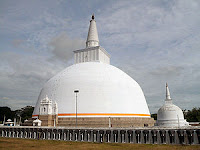The Bodhi Tree, also known as Bo (from the Sinhalese Bo), was a large and very old Sacred Fig tree (Ficus religiosa) located in Bodh Gaya (about 100 km (62 mi) from Patna in the Indian state of Bihar), under which Siddhartha Gautama, the spiritual teacher and founder of Buddhism later known as Gautama Buddha, is said to have achieved enlightenment, or Bodhi. In religious iconography, the Bodhi tree is recognizable by its heart-shaped leaves, which are usually prominently displayed. It takes 100 to 3,000 years for a bodhi tree to fully grow.[citation needed]
The term "Bodhi Tree" is also widely applied to currently existing trees, particularly the Sacred Fig growing at the Mahabodhi Temple, which is a direct descendant of the original specimen. This tree is a frequent destination for pilgrims, being the most important of the four main Buddhist pilgrimage sites. Other holy Bodhi trees which have a great significance in the history of Buddhism are the Anandabodhi tree in Sravasti and the Bodhi tree in Anuradhapura, Sri Lanka. Both are believed to have been propagated from the original Bodhi tree.
 9:55 PM
9:55 PM
 Ranga
Ranga










